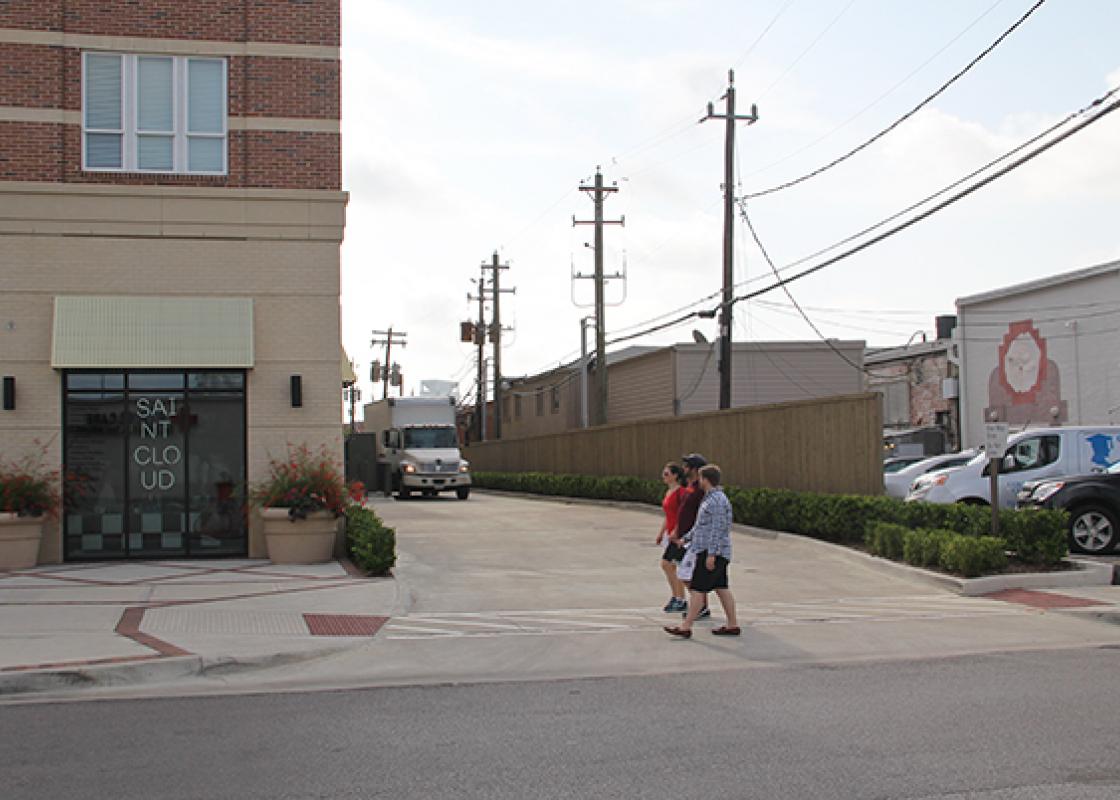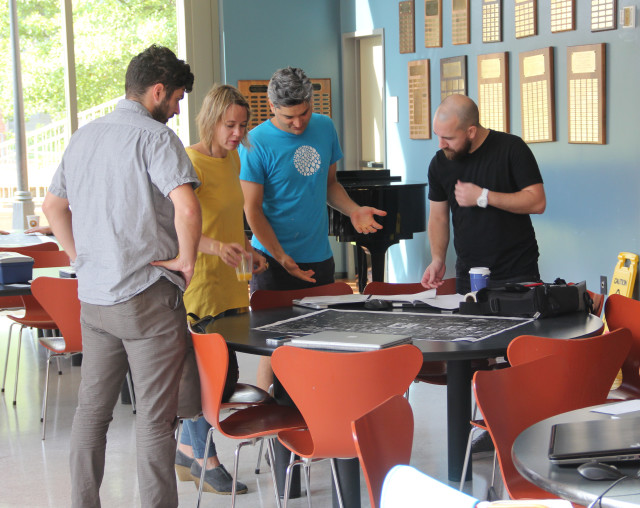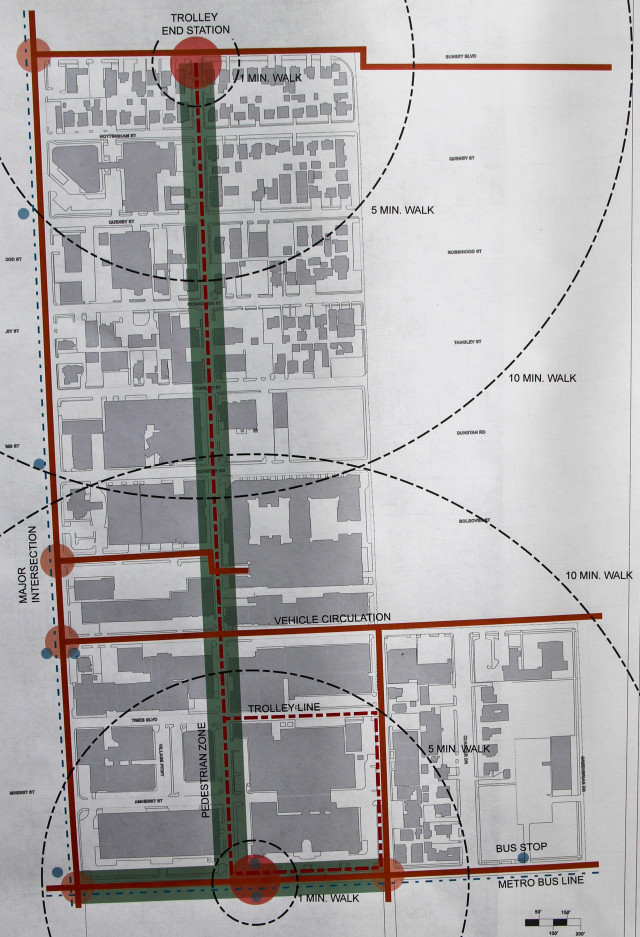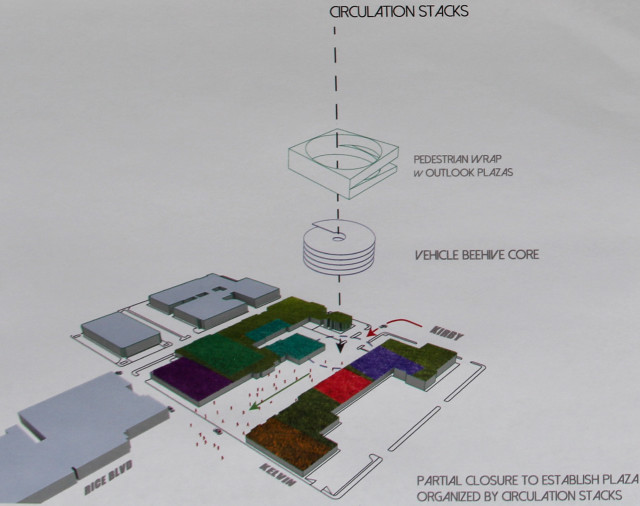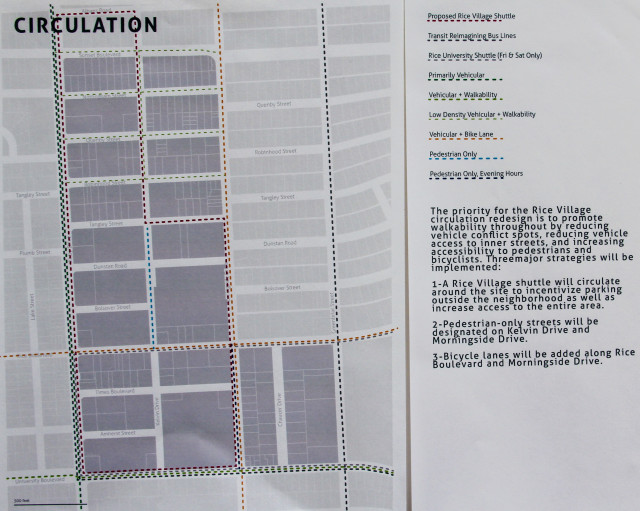In “It Fakes a Village,” an article published in the Spring 2006 issue of Cite (66), Daisy Kone derides the use of the word “village” for shopping enclaves like Highland Village that conjure a nostalgia for community without actually sustaining public life. Rather cars are given total primacy over the public realm. What does she have to say about the village, not the one in New York but Houston’s Rice Village?
She writes:
Conversely, in Rice Village, pedestrians share the street with drivers. Cars from the Texas Medical Center to Rice University to West University Place and beyond are filtered through Rice Village's strong street grid. Instead of slicing right through the middle of Rice Village, the traffic-laden arterial of Kirby Drive is an edge, and nobody walks it, just as no one does any arterial . . . Sidewalks in Rice Village, whose minimum width --- 2.5 to 3 feet --- is usually considered inadequate for pedestrian-friendly environments, are completely walkable. The short blocks, abundant four-way stops, and single-depth parking on every street slow auto speed and put barriers between cars and people, making walking completely non-threatening. The additional parking load is deposited in a centrally located, free parking garage that sits in the middle of a block, not directly on the street. Other smaller parking structures are placed on the north side, also off the street. Throughout the Village, the two-story building height and narrow travel-lane widths of the streets keep the scale appropriate to humans. Two mid-block passages through the buildings cut journeys in half for destinations on University, Rice, or Times Boulevards. This destination-driven urban plan has a rich mix of retail and service businesses. Ample supply of restaurants, and shared streets, all parts of a robust formula encouraging people to spend time there and celebrating the extravagant variety of the commonplace.
So, it seems, Rice Village defies the truism that Houston is entirely car-centric. Nonetheless, its streets, perhaps more so now than in the early 2000s, are often dominated by cars circling for the rare parking spot. Those narrow sidewalks often disappear mid-block. The scale of newer developments has jumped without an accompanying investment in the public realm. All in all, Rice Village seems less pedestrian-friendly than long-time Houstonians describe its early days. You don’t see kids walking from Kahn’s Deli to the G&G Model Shop.
rdAGENTS, the young professionals group of this blog’s publisher, organized a charrette called “Visions for the Village” that challenged participants to imagine how Rice Village can develop better mobility, walkability, and accessibility. On Saturday, August 2 from 9 a.m. to 5 p.m., 16 teams of designers worked intensely at Hanszen College at Rice University. The entries were judged by Neyran Turan, Assistant Professor at the Rice School of Architecture (RSA); Kathie Easterly, Executive Director of the University Place Association; and Andrew Albers, Vice President, The Office of James Burnett. The teams' boards were displayed August 4, at the RSA.
In her comments before presenting the winners of the 2014 RDA charrette, Emily Winters identified some of the common design approaches adopted by many of the teams. Nearly every design featured a pedestrian promenade or spine through Rice Village. In order to devote more space to wider sidewalks, plazas with band shells, and parks with water features, many teams changed lane widths, the number of lanes, and parking strategies.
Özge Gulec Inal and the team from Page won first place with a proposal that began with an analysis of the proximity of Rice Village to Rice University. A series of three simple diagrams suggest that Rice can develop the surface parking lots around its stadiums, the land it owns along Greenbriar, and its extensive holdings in Rice Village with an overarching strategy of integration and connectivity. Gulec Inal called for keeping the “hodgepodge” character of Rice Village. The word “hodgepodge” perhaps does a better job than “mixed-use” of getting across the virtues of a vibrant urban fabric, especially in the context of Houston. The uneven setbacks, the lack of uniformity in façades and materials, the shifts in scale, the old buildings and new, the tiny independent retail survivors --- that hodgepodginess saves Rice Village from becoming a simulacra, an Inner Loop imitation of the Outer Loop imitations of what we imagine urban life to be.
Ryan Horton and Jon Hale from the PGAL team that took second place propose a pedestrian promenade along Kelvin Street in which cars still have a lane in each direction. A stretch of Times Boulevard, however, is closed to cars and fully opened to pedestrians. They also propose residential development above the stores along the east side of Kirby Drive:
When I tried to take in all of the proposals, besides feeling awed by the talent of the participants, I was struck by how much we become what we fight and oppose. By trying to foster “walkability” we obsess over parking cars. A team that won a special award for “Most Visionary” proposed a 10-story monumental tower of parking at the site of the Village Arcade where Kubo’s is now. It is an extreme manifestation of an approach shared by several proposals: aggregate the parking in big garages along the boundaries. A tram can get people to within easy reach of their destination.
I learned a great deal from the teams that did not win any awards as well. Chelsea Serrano-Piche of Team 6 suggests painting parking lots green to encourage a multitude of uses at little expense. She also proposes swings big enough for adults to activate spaces. Those inexpensive little ideas tugged at something in me. I would love to have parks and plazas in Rice Village, and that seems achievable. However, I wonder at the feasibility of expensive, new transportation infrastructure. Rice Village does not have a TIRZ, Management District, or other way to finance a project. I'm impatient. I want change now. Put a swing on it. Put a B-cycle on it.
Maybe subtraction is needed. More disappearing sidewalks could help. Longer lines, more bodies spilling into the street. More children zigzagging on their bikes. At what point is a sidewalk a surrender of the rest of the public realm to the car? And what threshold must be crossed for the full street to become public and shared by all? In Europe, the Naked Streets movement has gained a foothold. They strip the street of all signs and rules. It is shared and slow, seemingly chaotic but safe. In India, that type of street is the norm.
In Houston, we have a tendency to want it all. We want to drive there and have the ultimate pedestrian experience. We can have it all, but only at great expense. (Susan Rogers made this point in an article about Uptown, an area that can finance infrastructure.) Each spot in a big garage can cost more than $10,000 to build. Underground parking is even more expensive. And those lots are enormously costly to maintain as has been meticulously documented by Donald Shoup in The High Cost of Free Parking. That brings me to one little diagram, not very splashy, by the team from Asakura Robinson. It shows where the city’s revised bus routes will run in relation to Rice Village. The new routes are to be implemented in one year. What if that really were a starting point? The same team proposed a Parking Benefit District. More meters could equalize the cost between street and garage so people don't circle endlessly looking for the perfect, "free" spot. That money can go into a collective fund to pay for the great improvements to the public realm proposed at the charrette.
After the charrette reception, my friend Charles Krenzler and I drove to Rice Village, parked near Torchy’s on Morningside, and ate at Kubo’s. On the way, right about where the sidewalk evaporates into the gaping maw of the Arcade garage, we passed a storefront with a sign for Uber, the app-based car service that has put both the global and local taxi industry in a panic by dramatically undercutting prices. Change is coming in one regulatory form or another. Perhaps, one day soon, bicycles, better buses, and cheaper taxi-like services, human-driven and autonomous, will deliver us to the hodgepodge pedestrian environments we dream of.


